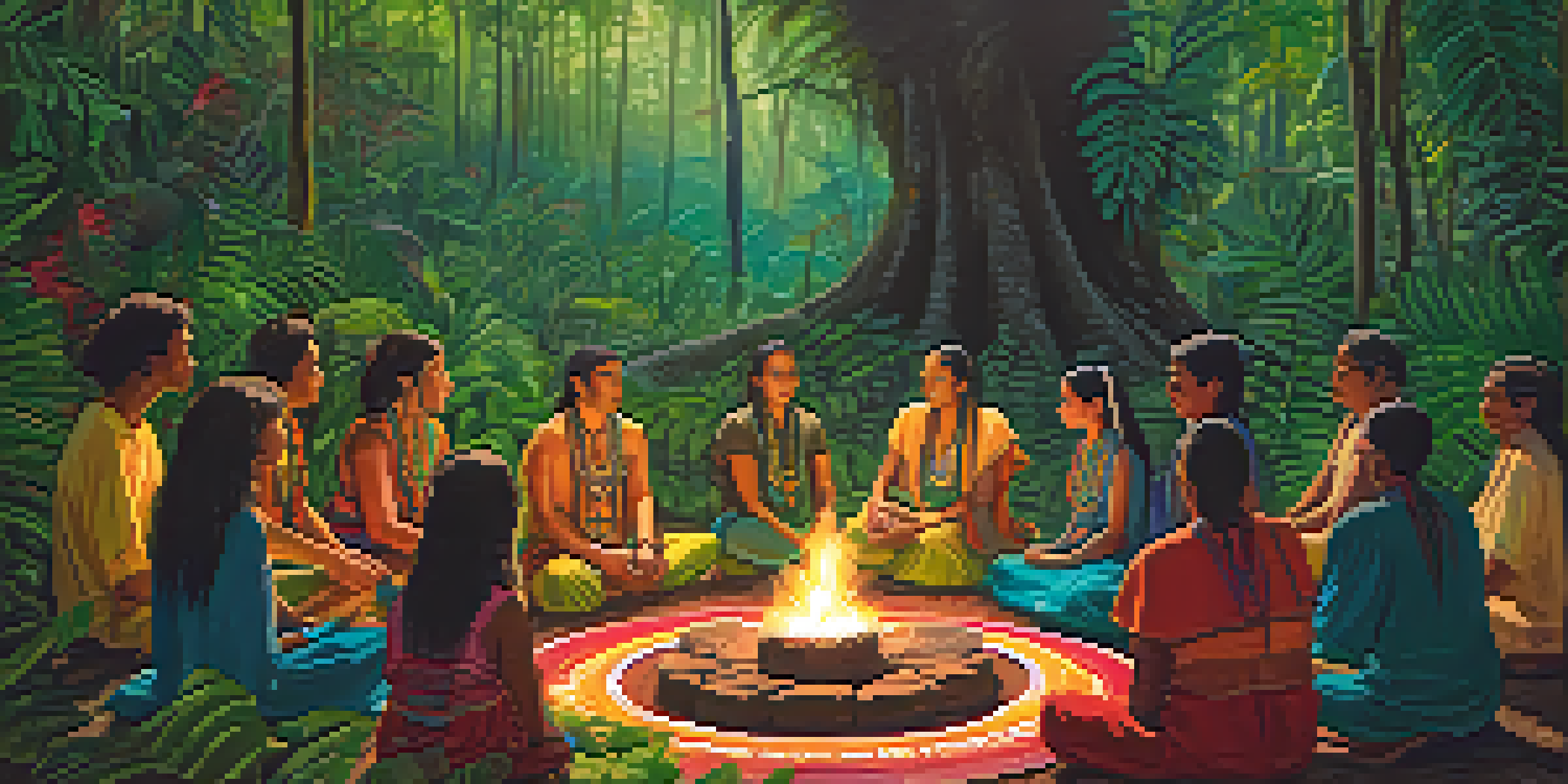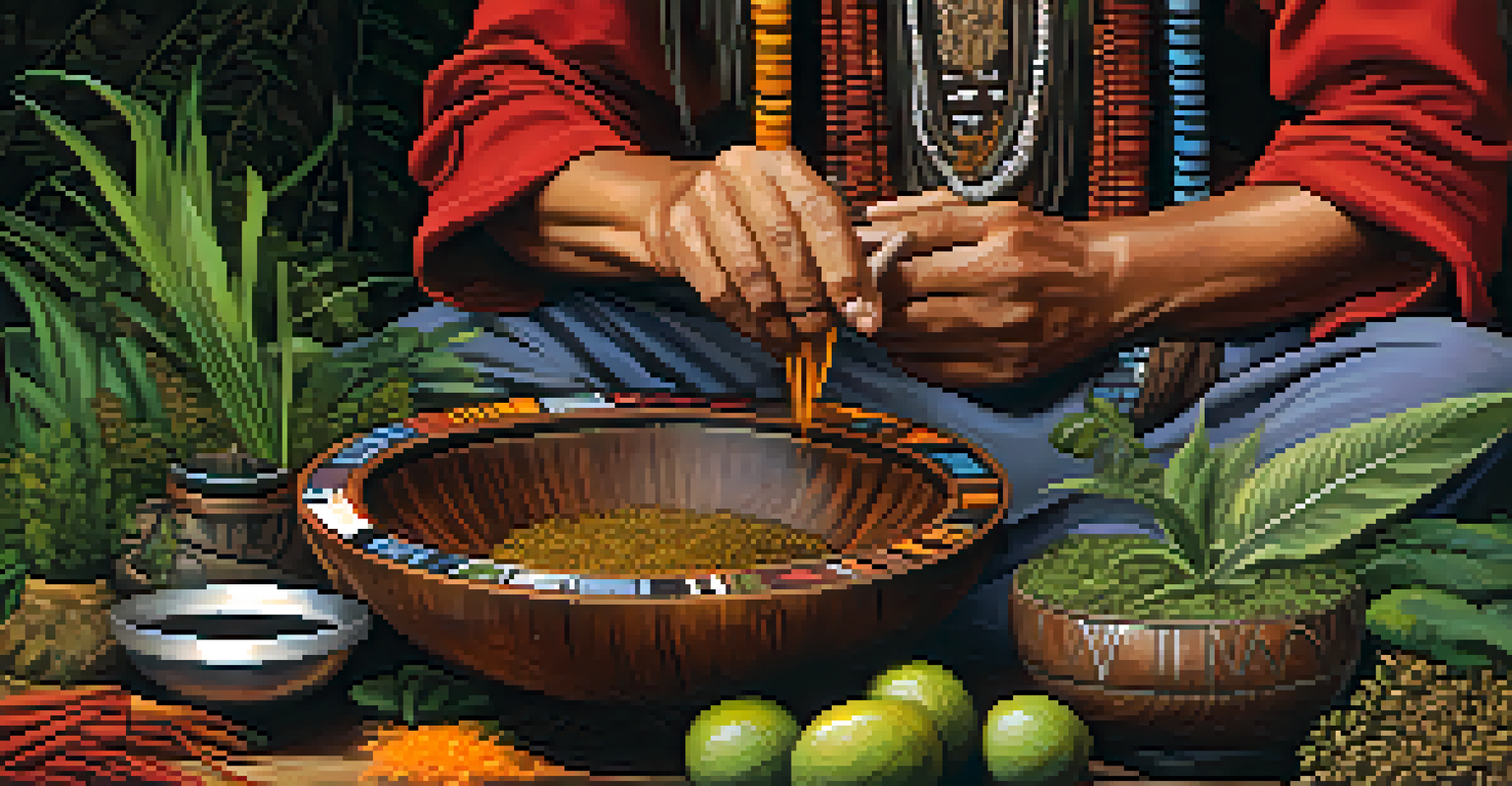Navigating Language Barriers in Ayahuasca Ceremonies

Understanding Ayahuasca and Its Cultural Context
Ayahuasca is a powerful brew originating from the Amazon, often used in spiritual ceremonies. It combines the Banisteriopsis caapi vine and the chacruna leaf, creating a profound experience that can lead to deep personal insights. However, many participants may find themselves in ceremonies where the primary language is not their own, making communication vital yet challenging.
Language is the road map of a culture. It tells you where its people come from and where they are going.
The cultural context of Ayahuasca ceremonies is rich and layered, often steeped in indigenous traditions. This complexity can create an atmosphere where language barriers feel even more pronounced. It’s essential to appreciate that the experience is not just about the drink but also about the shared communal and spiritual journey.
Understanding this cultural backdrop can help participants navigate language barriers more effectively. By recognizing the significance of language within these ceremonies, individuals can better prepare themselves for the experience, ensuring they can connect with both the shaman and fellow participants.
The Importance of Communication in Ceremonies
Communication is key in Ayahuasca ceremonies, as it facilitates connection and understanding among participants. Whether it’s sharing intentions or expressing feelings during the journey, being able to communicate effectively enhances the overall experience. Language barriers can disrupt this flow, leaving some individuals feeling isolated.

Moreover, the shaman’s guidance is crucial during the ceremony, often involving specific instructions or comforting words. If these are lost in translation, it could lead to confusion or even fear during an already intense experience. Therefore, establishing clear communication channels is essential.
Communication Enhances Ceremonies
Effective communication is vital in Ayahuasca ceremonies, as it fosters connection and understanding among participants.
Participants should consider discussing their communication preferences with the shaman or facilitators beforehand. This proactive approach can help mitigate misunderstandings and foster a more inclusive environment, allowing everyone to fully engage with the ceremony.
Using Translators and Bilingual Facilitators
One effective strategy for overcoming language barriers in Ayahuasca ceremonies is to utilize translators or bilingual facilitators. These individuals can bridge the gap between the shaman and non-native speakers, ensuring that vital messages and guidance are conveyed accurately. Their presence can significantly enhance the experience for those who might otherwise struggle to understand.
The greatest gift of human beings is that we have the power of empathy.
Many retreat centers now employ bilingual staff, which allows for a more harmonious environment. These facilitators not only translate words but also help convey the emotional and spiritual nuances of the ceremony. This deeper understanding can lead to a more fulfilling and transformative experience.
When choosing a retreat, consider inquiring about the availability of translators. Knowing that there will be someone to assist with communication can provide peace of mind, allowing participants to immerse themselves fully in the Ayahuasca experience without the worry of language barriers.
Non-Verbal Communication Techniques
When words fail, non-verbal communication can bridge the gap. In Ayahuasca ceremonies, body language, gestures, and facial expressions often convey emotions and intentions more powerfully than spoken words. This form of communication can foster connection and understanding, even among those who speak different languages.
For example, a reassuring touch from a fellow participant can provide comfort during challenging moments. Similarly, maintaining eye contact can convey empathy and support, creating a sense of unity within the group. Understanding these non-verbal cues can enhance the overall experience, allowing everyone to feel included.
Translators Bridge Language Gaps
Utilizing translators or bilingual facilitators can significantly improve the Ayahuasca experience for non-native speakers.
Participants should be mindful of their own non-verbal signals as well. Being open and approachable can encourage others to connect, regardless of language differences. Embracing non-verbal communication can thus enhance the community aspect of the ceremony, allowing for shared experiences that transcend linguistic barriers.
Preparing for an Ayahuasca Ceremony
Preparation is crucial for anyone attending an Ayahuasca ceremony, especially when language barriers are a concern. Before the ceremony, participants should familiarize themselves with common terms and phrases used by the shaman. This effort can help ease feelings of uncertainty and foster a sense of belonging.
Additionally, participants might consider discussing their intentions and any specific concerns with the retreat staff before the ceremony. This dialogue not only clarifies expectations but also helps staff provide tailored support during the experience. Knowing that there’s a plan in place can alleviate anxiety about potential language miscommunications.
Lastly, participants should arrive with an open mind and a willingness to connect. Embracing the unknown can lead to unexpected insights, making the journey even more meaningful. By preparing both mentally and emotionally, individuals can navigate language barriers with grace and confidence.
Post-Ceremony Reflection and Integration
After the Ayahuasca ceremony, taking time for reflection is essential, especially for those who faced language barriers. Sharing experiences with others can foster deeper connections and enhance understanding of the journey. This shared reflection can help participants process their emotions and insights, creating a supportive atmosphere.
Language barriers might have posed challenges during the ceremony, but post-ceremony discussions provide an opportunity to bridge those gaps. Participants can share their feelings about what they experienced, regardless of language proficiency. This process can lead to new friendships and a sense of community among those who attended the ceremony together.
Non-Verbal Cues Foster Connection
Non-verbal communication techniques, such as body language and gestures, can enhance understanding and unity during ceremonies.
Moreover, integrating the lessons learned from the ceremony into everyday life is crucial for personal growth. Participants should consider journaling, engaging in discussions, or seeking guidance from facilitators to help navigate this integration. By doing so, they can ensure that their Ayahuasca experience continues to resonate long after the ceremony ends.
Conclusion: Embracing Diversity in Ayahuasca Ceremonies
Navigating language barriers in Ayahuasca ceremonies can be challenging, but it also presents an opportunity to embrace diversity. Each participant brings unique perspectives and experiences, enriching the collective journey. By fostering an inclusive environment, everyone can benefit from the transformative power of Ayahuasca.
As we engage with different cultures and languages, we expand our understanding of the world around us. This commitment to inclusivity not only enhances the Ayahuasca experience but also promotes personal growth and connection among participants. It’s a reminder that, despite our differences, we share a common human experience.

Ultimately, the essence of Ayahuasca ceremonies lies in the connection we forge with ourselves and each other. By acknowledging and addressing language barriers, we can create a more profound and meaningful experience for all involved, ensuring that the spirit of Ayahuasca transcends linguistic limitations.